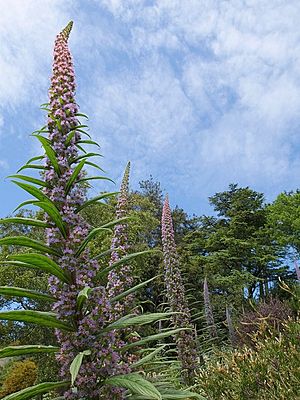Tree echium facts for kids
Quick facts for kids Tree echium |
|
|---|---|
 |
|
| Conservation status | |
| Scientific classification | |
| Genus: |
Echium
|
| Species: |
pininana
|
Echium pininana, also called the tree echium or tower of jewels, is a tall flowering plant. It belongs to the borage family, called Boraginaceae. This plant naturally grows only on the island of La Palma in the Canary Islands.
Echium pininana is an endangered species. This means it is at risk of disappearing from the wild. It is protected by an agreement called the Convention on the Conservation of European Wildlife and Natural Habitats. The plant's scientific name, pininana, is Latin for "small pine". However, it is not related to pine trees and does not look like them.
Contents
About the Tower of Jewels
Plant Life Cycle
Echium pininana is a biennial or triennial plant. This means each plant lives for only two or three years. It is also a monocarpic species. This means each plant flowers only once in its life before it dies.
What the Plant Looks Like
In its first year, the plant grows a flat group of leaves called a rosette. These leaves are about 7 centimeters (2.75 inches) long and have silver hairs. The plant also grows a main stem, or trunk, which can be 1 to 2.4 meters (3 to 8 feet) tall. This trunk is covered with many leaves.
In its second or third year, the plant grows a tall, cone-shaped flower spike. This spike can reach up to 4 meters (13 feet) high! It has many leaves and small blue flowers. Between April and June, the flower spike can grow 5 centimeters (2 inches) every day.
The flowers are shaped like funnels. Each flower makes a tiny bit of sweet liquid called nectar. This nectar is about 26% sugar. Flowers at the bottom of the spike open first, and those at the top open last. Pollinators like bees, butterflies, and moths love these flowers. After the flowers are pollinated, each one makes four small seeds. One plant can produce over 200,000 seeds! These seeds are spread short distances by the wind.
Plant Safety
Echium pininana contains natural chemicals called pyrrolizidine alkaloids. These chemicals can be harmful. The plant is known to be unsafe for horses to eat.
Where the Plant Grows
Echium pininana grows naturally only on La Palma island in the Canary Islands. There, it lives in laurel forests. It is endangered because its natural home is being lost due to agriculture.
However, Echium pininana has been planted in other places around the world. You can find it in France, Great Britain, Ireland, New Zealand, and parts of the United States. It is also grown in special plant collections, like botanical gardens. In fact, there are more of these plants in gardens than in the wild! Famous gardens like Kew Gardens in London grow them.
Growing Echium pininana
Many people grow Echium pininana in their gardens because it is a beautiful ornamental plant. It has even won an award from the Royal Horticultural Society. Gardeners often use it as a bedding plant or in flower borders. It grows best in sunny spots.
It is often recommended for warmer coastal areas of England, the Channel Islands, and the Scilly Isles. But some people have successfully grown it in colder parts of England and in Yorkshire. It also grows well in Dublin gardens and in North Wales, where it spreads its seeds widely.
Even though E. pininana is not fully hardy in Britain and Ireland, it can self-seed. This means new plants grow from its own seeds. Over time, hardier types of the plant might appear. Young plants are most sensitive to frost. Because its leaves are very large, strong winds can also damage the plant. So, it needs a sheltered spot in a garden. There is also a type called Echium pininana 'Alba' which has white flowers.
See also
 In Spanish: Pininana para niños
In Spanish: Pininana para niños


